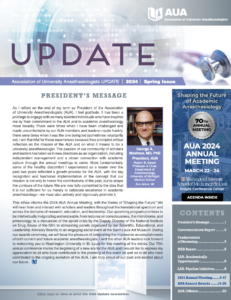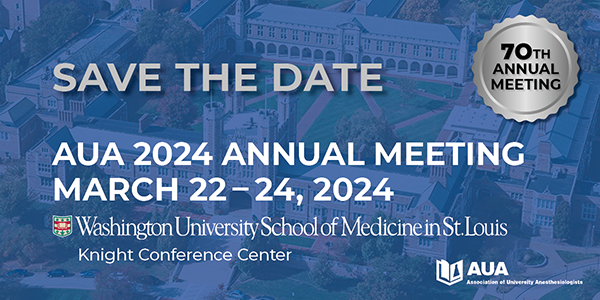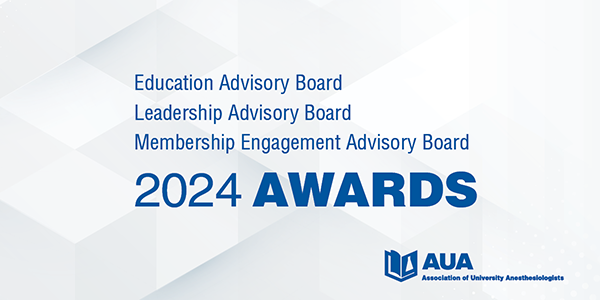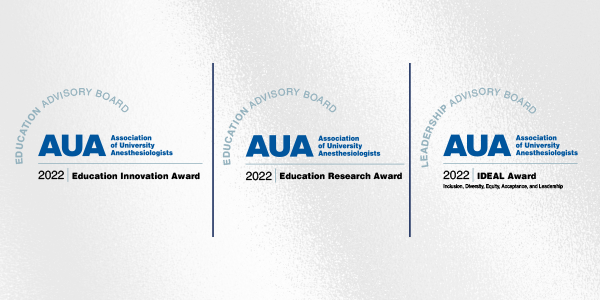President’s Message
AUA Leadership
The AUA has had another successful year, and on behalf of the AUA council I would like to express sincere gratitude to Jeanine Wiener-Kronish for her effective and inspiring leadership as AUA president over the last two years. Indeed, Jeanine has had a hand in many of our strategic initiatives, and has contributed substantially to the AUA’s recent accomplishments, including our recent meeting in Chicago. Luckily, Jeanine will continue to serve on the AUA Council as past president, and we will derive benefit from her leadership experience, her commitment to academic anesthesiology, and her impressive insights. Others who have left their roles on the AUA council are Tom Blanck, who was the past president, and Aman Mahajan, who was a councilor-at-large. We thank Tom and Aman for their years of service as AUA leaders. Aman Mahajan was elected at the business meeting in Chicago to represent the AUA at the Council of Faculty and Academic Societies Representatives.
Following his stint as a meticulous treasurer, Jeff Kirsch was elected AUA secretary. In that role he helped to establish the AUA’s associate membership category, and increased overall AUA membership, including international leaders in anesthesiology. Jeff has now moved into the role of president elect. Bob Pearce is the current AUA treasurer. We have been fortunate to have a person of Bob’s caliber in charge of our purse strings. Bob has been thoughtful in his financial management, ably assisted by Tom Cooper and the IARS administrative team. Thanks to membership growth, outstanding meeting attendance, and fiduciary responsibility, the AUA’s balance has been substantially positive, and we have been able to devote resources to mission based activities. Notably, we have committed $45,000 to the clinical trials initiative and have increased our contribution to FAER this year to $50,000.
We are pleased to welcome George Mashour and Monica Vavilala to the AUA council. George was elected at the AUA business meeting in Chicago to the position of secretary. After two years in that role, he will take on the mantle of president elect. Monica was elected as a councilor-at-large. Her tenure in that role will be three years. George Mashour is the Bert N. La Du Professor of Anesthesiology Research at the University of Michigan. He is also the Associate Dean for Clinical and Translational Research, the Director of the Michigan Institute for Clinical & Health Research, and the Director, Center for Consciousness Science at the University of Michigan Medical School, Ann Arbor. Monica Vavilala is the Vice Chair for Strategic Affairs in the Anesthesiology and Pain Medicine Department at the University of Washington in Seattle. She is also a Professor of Pediatrics and the Director of the Harborview Injury Prevention and Research Center at the University of Washington.
Other current members of the AUA council are Michael Gropper and Lena Sun (both councilors-at-large) and Lisa Wise-Faberowski (Communications and Website Committee Chair). Lisa and her committee have embraced and elevated the critical communications functions of the AUA. Ines Koerner has been selected to lead our Scientific Advisory Board and Keith Baker has been chosen to head up our Educational Advisory Board. We are grateful to Ines and Keith for the incredible work that they and their boards do for the AUA. Without the dedication and service of the Scientific Advisory Board (SAB) and the Education Advisor Board (EAB), the AUA would not be able to accomplish its goals. I would also like to thank Y.S. Prakash (past chair SAB), Bob Gaiser (past chair EAB) and their board members for their substantial contributions to the AUA.
The Meeting
Our alliance with SOCCA and the IARS has continued to bear fruit, with record attendance at this year’s annual meeting in Chicago. It is important to reflect that this high attendance included many early stage scholars, associate members and academics in anesthesiology from outside the United States. We welcome the expansion and growing impact of the AUA meeting. Many people have provided feedback regarding the meeting, and apart from concerns about the poster sessions (poor choice of venue), the sentiments have been overwhelmingly positive. Special thanks go to the meeting organizers, including the host anesthesiology departments at Northwestern University Feinberg School of Medicine (Charles W. Hogue) and the University of Chicago, Illinois (Jeffrey L. Apfelbaum and Peter Nagele). The host institution program was inspiring as always, and the social event at the Chicago Stock Exchange Trading Room in the Art Institute of Chicago was magnificent. The EAB under Robert R. Gaiser and the SAB under Y.S. Prakash organized compelling sessions on Thursday and Friday, as well as on the aligned days during the IARS meeting (e.g., the symposium on Mitochondria and Bioenergetics). The quality of the science presented by early stage anesthesiology scholars was heartening and inspiring. Congratulations to all the award winners. Thanks, as well, to Jeanine Wiener-Kronish for inviting world leaders in sepsis across the translational spectrum for a provocative, erudite and entertaining panel. We look forward to our meeting in Montreal next year and are optimistic that we can continue to elevate the scientific and educational content.
Strategic Initiatives
I would like to highlight three of our key initiatives. The first is our alliance with the IARS and SOCCA. As hoped, this association has enhanced the meetings of all three societies, and has broadened the reach and influence of the AUA on our anesthesiology and related fields. The concerns regarding the potential loss of the host program have not have been unfounded, since there has been a deep commitment among AUA leadership to retain positive features of our meeting, while expanding our scope and welcoming a broader audience. Going forward, we anticipate closer cooperation, especially regarding scientific posters and high profile scientific symposiums.
Second, I would like to comment on the growing strength of the Early Stage Anesthesiology Scholars (eSAS) initiative. The AUA has been steadfast in supporting eSAS and encouraging its development. This year’s eSAS meeting was extremely well organized and the content was pitched perfectly for early stage scholars. The AUA will continue to offer support to eSAS and to provide mentorship for tomorrow’s leaders in our field. Congratulations to Julie Freed and Aaron Norris on their election as eSAS presidents. I hope that they continue to lead eSAS boldly and progressively.
The third initiative to showcase was the successful launch of a program for pragmatic clinical trials in the United States. The AUA (in collaboration with the IARS, FAER, SOCCA, eSAS) organized a competition to award three proposals seed funding to develop compelling grant applications for practical trials. Seventeen strong applications were received, and with the help of an experienced and dedicated study section, three winners were selected. I congratulate them on this accomplishment. Visit https://mpog.org/ctn/ for details on the winning proposals. Doctors Michael Aziz, Frederic (Josh) Billings and Bhiken Naik (on behalf of Randal Blank) presented their proposals to an audience of their peers on May 1 in Chicago. They received feedback from experienced investigators and will use their $15,000 awards to refine their proposals. Representatives of the National Heart Lung and Blood Institute (Catherine Stoney), the Canadian Perioperative Clinical Trials Group (Eric Jacobsohn), Multicenter Perioperative Outcomes Group (Sachin Kheterpal) and the Duke Clinical Research Institute (Paul Wischmeyer) delivered high quality and powerful presentations at this event. Going forward, the AUA will hopefully continue to partner with the IARS, FAER, SOCCA, eSAS, as well as with clinical trials networks around the world, to increase the quality and participation of anesthesiology in large, pragmatic trials.
Before signing off, I would like to extend special thanks to Tom Cooper, Vivian Abalama, Meghan Whitbeck and other members of the IARS administrative team for everything they have done to help the AUA as we have grown and made important advances. This administrative team has consistently been organized, professional and committed. They have contributed much to our recent successes.











